By Adam Pagnucco.
The precinct results on Montgomery County’s Question B, the charter amendment imposing term limits on the County Executive and County Council, are in. The message they contain has significant implications for the next election.
First, let’s look at the overall results by type of vote. Term limits passed overwhelmingly among early voters, election day voters and absentee and provisional voters, though early votes were lower than the other two categories. As an aside, check out how early votes comprised a third of all votes, reflecting the growing popularity of this type of voting.

Next, let’s examine the distribution of precincts by vote results. Ninety percent of the county’s 257 precincts passed term limits by at least twenty points. Only four(!) precincts voted against term limits. Of those, three were in Takoma Park and the other was in Silver Spring inside the Beltway.
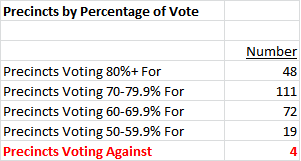
Below are the results for Congressional, state legislative and council districts as well as a cut distinguishing inside vs outside the Beltway. Again, every single split shows huge support for term limits, with Upcounty areas higher than Downcounty areas.

Now let’s look at results by local area. Every area in the county passed term limits by at least 20 points except for Takoma Park – the only place that voted against term limits. Clarksburg, Damascus, Derwood, Laytonsville, North Potomac and Poolesville had support for term limits of 80% or more.
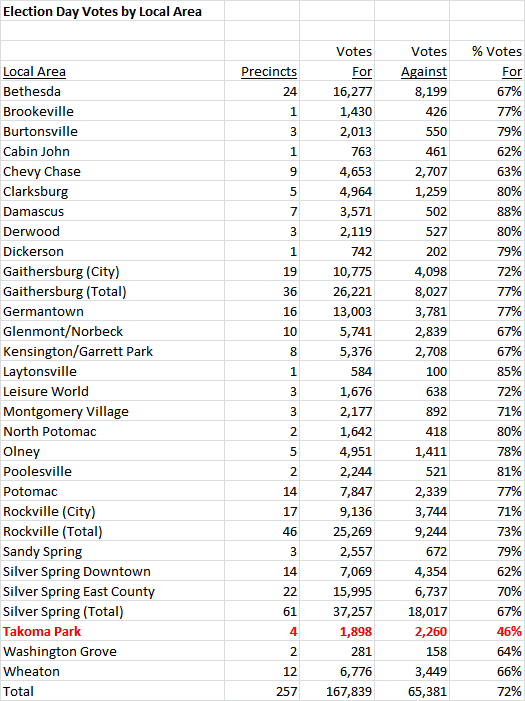
We contrasted the election day results of the term limits votes in 2004 and 2016 to calculate where support for term limits had grown the most. An important caveat: early voting did not exist in 2004 so that may impact the nature of this presentation. Overall, support for term limits among election day voters grew from 48% to 72%, a change of 24 points, and most areas had changes in that ballpark. There are two exceptions. Takoma Park, where term limits support grew by 17 points, had the least change. Leisure World, where support grew by 32 points, had the most change.
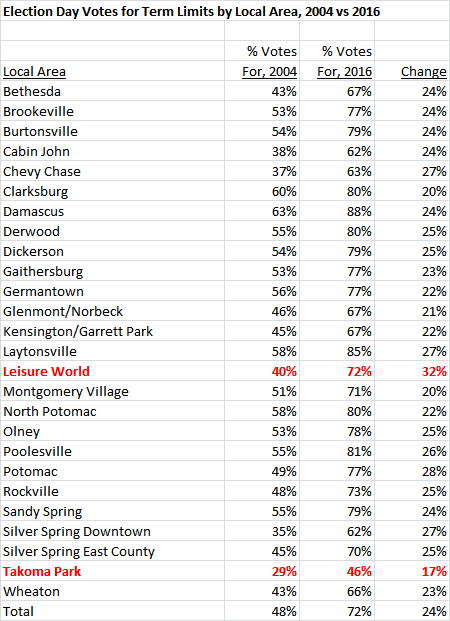
Below are the results on precinct demographics. There is very little variation between heavily white, black, Hispanic or Asian precincts, indicating close to uniform support for term limits.
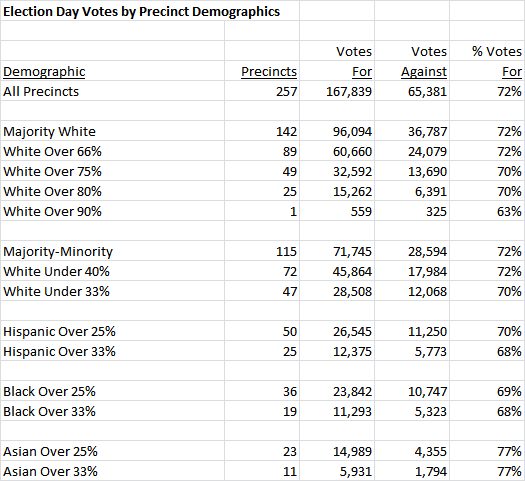
The partisan nature of precincts was an important predictor of term limits voting. The chart below shows term limit votes by the precinct registration percentages of both major parties. Precincts that were the least Democratic and the most Republican passed term limits with more than 80% of the vote. Precincts that were the most Democratic and the least Republican passed term limits with more than 60% of the vote. The correlation coefficient between these two measures was 0.60, indicating a significant relationship between them.
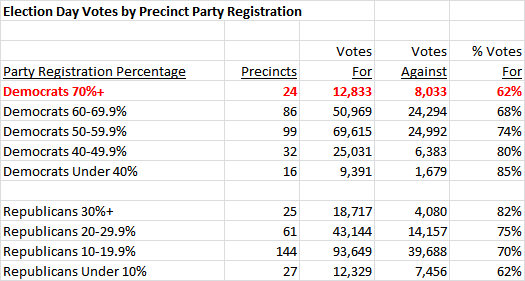
The big question now is how the term limits vote will affect the 2018 Democratic primary. Let’s remember that the presidential general electorate and the mid-term Democratic primary electorate are two very different groups of people. In 2014, Democratic primary voters supported every county-level incumbent running for reelection only to have presidential general voters effectively kick them out two years later. Nevertheless, there is substantial evidence that many voters who supported term limits will be voting in the 2018 Democratic primary.
- At least half of county Democrats voted for term limits. Consider the following. First, 60% of MoCo presidential general election voters are Democrats. Second, if all the Republicans and unaffiliated voters supported term limits, that would be 40% of the vote. However, term limits passed with 70% of the vote. So that extra 30 points must have come from Democrats and would account for half of them. If any Republicans or unaffiliated voters did not support term limits, then a slight majority of Democrats would have voted yes. The point here is that term limits could not have hit 70% support without massive numbers of Democrats favoring them.
- Almost all of the Downcounty Democratic strongholds – Bethesda, Chevy Chase, Kensington and Downtown Silver Spring – passed term limits by more than 20 points. Only Takoma Park voted no. These are the same areas that voted overwhelmingly for Jamie Raskin in the 2016 primary and are responsible for sending him to Congress. In the 24 precincts where Democrats accounted for 70% or more of registered voters, term limits passed with 62% of the vote.
- Nearly two-thirds of regular MoCo Democratic primary voters are age 60 or older. This makes the term limits vote in Leisure World especially noteworthy. In 2004, 40% of Leisure World voted for term limits, eight points below the county average. In 2016, 72% of Leisure World voted for term limits, the same as the county average. That 32-point shift was the biggest of any local area in the county. The importance of seniors among Democratic voters cannot be overstated and their huge shift in favor of term limits is deeply meaningful.
The term limits vote was the biggest revolt of MoCo voters in at least fifty years. Everyone running for office in 2018 – incumbents, challengers and open seat candidates alike – must take that into account.
